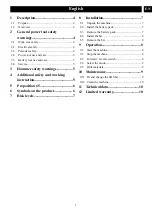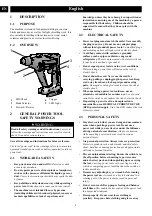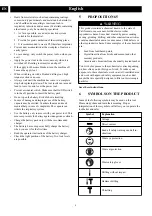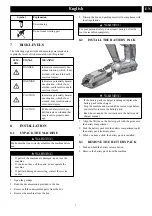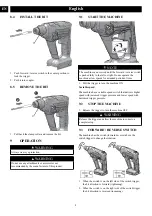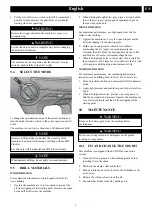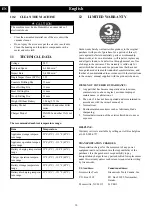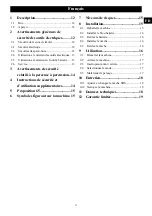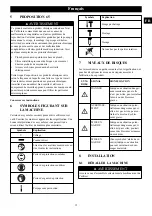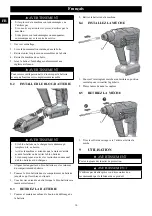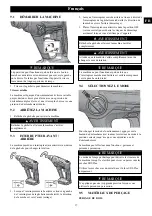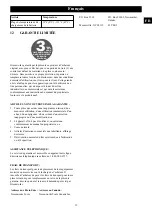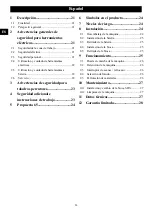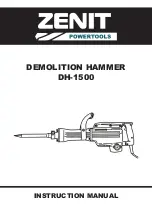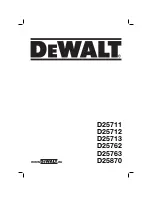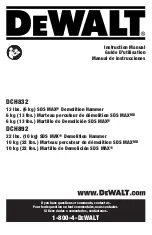
from moving parts. Loose clothes, jewellery or long hair
can be caught in moving parts.
•
If devices are provided for the connection of dust
extraction and collection facilities, ensure these are
connected and properly used. Use of dust collection can
reduce dust related hazards.
2.4
POWER TOOL USE AND CARE
•
Do not force the power tool. Use the correct power
tool for your application. The correct power tool will do
the job better and safer at the rate for which it was
designed.
•
Do not use the power tool if the switch does not turn it
on and off.
Any power tool that cannot be controlled with
the switch is dangerous and must be repaired.
•
Disconnect the plug from the power source and/or the
battery pack from the power tool before making any
adjustments, changing accessories, or storing power
tools. Such preventive safety measures reduce the risk of
starting the power tool accidentally.
•
Store idle power tools out of the reach of children and
do not allow persons unfamiliar with the power tool or
these instructions to operate the power tool. Power
tools are dangerous in the hands of untrained users.
•
Maintain power tools. Check for misalignment or
binding of moving parts, breakage of parts and any
other condition that may affect the power tool’s
operation. If damaged, have the power tool repaired
before use. Many accidents are caused by poorly
maintained power tools.
•
Keep cutting tools sharp and clean. Properly
maintained cutting tools with sharp cutting edges are less
likely to bind and are easier to control.
•
Use the power tool, accessories and tool bits etc. in
accordance with these instructions, taking into
account the working conditions and the work to be
performed. Use of the power tool for operations different
from those intended could result in a hazardous situation.
2.5
BATTERY TOOL USE AND CARE
•
Recharge only with the charger specified by the
manufacturer. A charger that is suitable for one type of
battery pack may create a risk of fire when used with
another battery pack.
•
Use power tools only with specifically designated
battery packs. Use of any other battery packs may create
a risk of injury and fire.
•
When battery pack is not in use, keep it away from
other metal objects like paper clips, coins, keys, nails,
screws, or other small metal objects that can make a
connection from one terminal to another. Shorting the
battery terminals together may cause burns or fire.
•
Under abusive conditions, liquid may be ejected from
the battery; avoid contact. If contact accidentally
occurs, flush with plenty of soap and water. If liquid
contacts eyes, immediately seek medical help. Liquid
ejected from the battery may cause irritation or burns.
2.6 SERVICE
•
Have your power tool
serviced by a qualified repair
person using only identical
replacement parts.
This will
ensure that the safety of the
power tool is maintained.
3
HAMMER SAFETY WARNINGS
•
Wear ear protectors. Exposure to noise can cause
hearing loss.
•
Use auxiliary handle(s), if supplied with the tool. Loss
of control can cause injury.
•
Hold the power tool by insulated gripping surfaces,
when performing an operation where the cutting
accessory may contact hidden wiring. Cutting
accessory contacting a "live" wire may make exposed
metal parts of the power tool "live" and could give the
operator an electric shock.
4
ADDITIONAL SAFETY AND
WORKING INSTRUCTION
•
When transporting and storing, set the rotational direction
switch to the centre position. Risk of injury when
accidentally actuating the On/Off switch.
•
Use appropriate detectors to find if utility lines are hidden
in the work area or call the local utility company for aid.
Contact with electric lines can lead to fire and electrical
shock. Damaging a gas line can lead to explosion.
Penetrating a water line causes property damage.
•
Firmly tighten the auxiliary handle, hold the machine
firmly with both hands while working and keep proper
footing and balance at all times. The machine is securely
guided with both hands.
•
Secure the workpiece. A workpiece clamped with
clamping devices or in a vice is held more secure than by
hand.
•
For drilling without impact in wood, metal, ceramic and
plastic as well as for screwdriving, tools without SDS-
plus are used (e.g. drills with cylindrical shank). For these
tools, a keyless chuck or a key type drill chuck are
required.
•
The quick change chuck is automatically locked. Check
the locking effect by pulling the quick change chuck.
•
Replace a damaged dust protection cap immediately. The
dust protection cap largely prevents the penetration of
drilling dust into the tool holder during operation. When
inserting the tool, pay attention that the dust protection
cap is not damaged.
5
English
EN
Summary of Contents for HMG405
Page 2: ......



